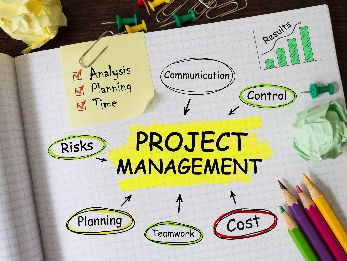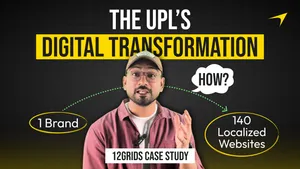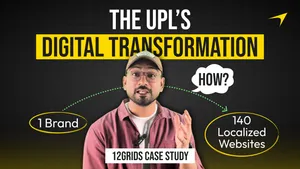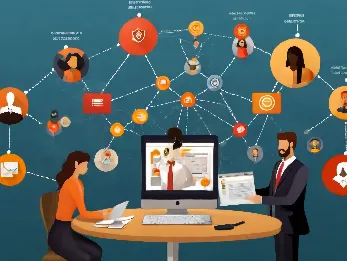Top 10 Project Management Methodologies: An Overview
7 mins | 21 Mar 2024

"Project,” a frequently used word in our daily lives, means a planned sequence of different tasks to be completed within a defined timeline to attain a specific goal. The Project Management Institute defines it as “any temporary endeavor with a definite beginning and end." Now, why is project management so important?
Unlike regular business operations, a project involves a distinct set of tasks that don't usually overlap with daily routines. Those involved in a project might not typically work together and could be from different organizations or locations. Without proper planning at each stage, achieving the desired outcome becomes challenging. To ensure success, it's crucial to manage the project professionally, meeting specific goals within the allocated time and budget.
Let’s dive deep to understand what project management is and how it is useful.
What is Project Management, and How is it Useful?
Often, projects are divided into different phases. The division of these phases is needed to cater to smooth processes and error-less functioning. Each phase has different tasks, objectives, and deadlines, and skilled professionals are working on them. Keeping track of ongoing tasks and achieving the desired objective at the end of each phase requires a special plan of action.
In simple terms, this plan of action is called Project Management. It is an application of processes, methods, and skills of professionals to achieve a specific goal. Project management makes it easier for any business to keep track of ongoing project activities and helps it monitor and rectify any loopholes that may cause a delay or an error in the project’s goal.
Project management is essential for successful projects so that we can easily achieve certain goals within a set scope, time, and budget. It adds organization and structure to project activities by dividing down tasks, defining deadlines, and efficiently allocating resources.
Furthermore, project management guarantees that projects stay within budget by carefully estimating costs and continuously monitoring spending. Quality assurance procedures are implemented throughout the project's lifespan to ensure that results meet or surpass expectations.
Unlike ‘management’, Project Management has a definite timespan and a specific goal at the end. However, it needs a set of skilled developers, an expert project management team, and certainly professional teams who have excellent business process understanding to make a project successful.
What is Project Management Methodology?
A project management methodology is a collection of principles, tools, and techniques for planning, executing, and overseeing projects. These methodologies allow project managers to effectively guide team members and oversee project tasks while promoting team collaboration.
There are various project management approaches, each with pros and downsides.
Some methodologies are better suited for specific industries or types of projects. Therefore, it's essential to familiarize yourself with different project management methodologies to determine which one aligns best with your needs.
Why is a Project Management Methodology Required?
While project management is an application of processes and methods, project management methodology is defined as the system or rules for managing a project. As discussed earlier, a project is not bound to a specific team or geography; these methodologies help streamline the process by using a standardized set of rules that can be easily adapted across each phase of the project and help project managers reduce the risks of duplication errors and delayed task completion.
There are ample benefits to the adoption of project management methodologies. It helps to quickly adapt to new challenges and optimize resources within a specific budget. Cost-effectiveness and recurring success can be achieved by increasing the productivity of the project team. It helps achieve more successful project deliveries, which ultimately results in stakeholder satisfaction in the business and lead generation.
As the digitization of business processes has increased within the past few years, several project management methodologies have become common in different organizations. Let’s go through some of the most popular project management methodologies.
10 popular Project Management Methodologies
Project management keeps changing as time goes by, and more and more projects come up in organizations. Because of this, the ways we manage projects also keep changing. Let’s take a quick overview of the top 10 commonly used project management methodologies that will help you select which one will be the best for your project.
1. Waterfall Methodology
The waterfall is a step-by-step way of managing projects where each part of the project happens one after the other. It started in industries like making things and building stuff, where you have to finish one part before moving on to the next.
For example, you can't put up walls in a house until you've made the foundation.
Even though it started in making things, waterfall project management is now used in many different areas, like making software. Here's how it works:
1. You plan out the whole project.
2. You do one part at a time, finishing each part before moving on to the next.
3. It's called a "waterfall" because each part flows into the next, like a waterfall flowing down steps.
4. You can see this process in a chart where each step leads to the next one.
When to use it: The waterfall project management method is good when you know exactly what needs to be done from the start, and when the project isn't likely to change much. It's great for following a step-by-step plan, especially with a small or experienced team. It's also good for industries like construction or software development where things need to be done in order.
Advantages:
- Completion of each phase is required before moving to the next, ensuring structured progress.
- Well-suited for smaller projects with clearly defined requirements.
- Relies primarily on the project team, minimizing client involvement.
- Offers a straightforward approach for task understanding, tracking, and organization.
- Establishes milestones and deadlines for project progress.
Disadvantages:
- Errors can only be addressed within the current phase, limiting flexibility.
- Valuable client feedback cannot be incorporated until later stages of development, reducing the likelihood of making changes at the initial stages.
- Extensive documentation demands significant time from developers and testers.
- Working products are not produced until later stages, delaying tangible outcomes.
- Not suitable for complex or high-risk projects due to its limitations.
2. Agile Methodology
This project management methodology is handy for projects that undergo frequent fluctuations in their processes. Projects are completed in a shorter amount of time, known as iterations. The teams working on the project are supposed to provide the specific deliverables at the end of each phase. Its popularity has surpassed that of the waterfall method as it allows team members to make necessary changes anytime without waiting to complete the entire project.
Also, this method involves frequent testing, reassessment, and other adaptations. All-in-all, a dynamic approach to project management. Agile methodology is combined with Scrum, Kanban, extreme programming, Crystal, or even Scrumban to achieve an all-around detailed success of the project.
When to use it: When the stakeholders or client is involved in the project’s progress and are not sure about the deliverable or the final output. It is commonly used when the project is likely to fluctuate during any phase of the process. The ultimate trick to using Agile methodology is to combine it with the apt method for desired success.
Advantages:
- Agile ensures continuous software delivery, satisfying customers with incremental features.
- Customers receive working features after each sprint, facilitating feedback and adjustments.
- Daily interactions foster collaboration between business people and developers.
- Agile accommodates changes in requirements, enhancing flexibility.
- The Agile/Scrum approach promotes organizational synergy and trust, aligning teams around common goals.
Disadvantages:
- Minimal documentation in Agile complicates onboarding for new team members.
- Progress measurement is more complex compared to Waterfall.
- Agile demands increased time and energy from stakeholders due to constant interaction requirements.
- Developers may face idle periods, hindering productivity.
- Unclear requirements make it challenging to predict project outcomes accurately, leading to potential risks.
3. Scrum Methodology
Popularly involving short "sprints," also known as short cycles, this method is one of the most flexible methodologies. As the name says, this method is ideal for projects for which not more than 10 people are working. In this method, a two-week short cycle with daily scrum meetings is held by the scrum master. In other words, the scrum master, or the project manager, leads demos, sprints, and sprint retrospectives after each sprint is completed.
These meetings aim to connect project stakeholders and ensure the timely completion of each task. This methodology is usually combined with the Agile method because of the common factor of collaboration and valuing individuals over processes.
When to use it: Mostly, this method is used for a smaller team size of not more than 10.
This method works wonders for projects that don’t have a well-defined scope. Often used in the software industry, but being a flexible method, this method can also be utilized in retail logistics or event management.
Advantages:
- Scrum facilitates swift and efficient completion of project deliverables.
- Effective utilization of time and resources is ensured with Scrum.
- Large projects are broken down into manageable sprints for better management.
- Development and testing occur concurrently during sprint reviews.
- Well-suited for dynamic and fast-paced development projects, Scrum promotes agility and responsiveness.
Disadvantages:
- Scope creep is common in Scrum due to the absence of a fixed end date.
- Project failure risks increase if team members lack commitment or cooperation.
- Implementing Scrum in large teams presents challenges.
- Success with the Scrum framework depends heavily on the experience of team members.5. Daily meetings may lead to frustration among team members and disrupt workflow.
4. Critical Path Method (CPM)
Developed by Morgan R. Walker of DuPont and James E. Kelley, Jr., of Remington Rand in the late 1950s, the Critical Path Method, or CPM, helps the project manager identify and schedule critical tasks within a project by building a work breakdown structure. This includes any task dependencies and marks off milestones to indicate larger phases of the project.
This method helps identify the longest sequence of tasks needed to complete the project—the critical path! The project manager needs to keep an eye on each of those critical tasks because if one of them is delayed, it's a house of cards—everything is delayed!
When to use it: The CPM method is useful when there are task dependencies within a project. It is more suitable for mid-size projects. The project manager must determine critical tasks and allocate resources accordingly to complete the project within the specific timeline for the success of this method. It is popularly used in the construction, aerospace, defense, and software industries.
Advantages:
- Facilitates identification of parallel activities, optimizing project timelines.
- Helps project managers pinpoint critical project elements efficiently.
- Provides a practical and structured framework for goal attainment.
- Effective in managing new project endeavors.
- Enhances team cohesion when implemented correctly.
Disadvantages:
- Does not address personnel scheduling within the methodology.
- Estimating activity completion time can be challenging in CPM.
- Critical path determination may not always be straightforward.
- CPM networks can become complex for larger projects.
- Resource allocation scheduling is not handled within the CPM framework.
5. Kanban Methodology
This method uses a “Kanban Board," which provides a visual chart that includes a set of columns, each column representing one stage of the process. The name Kanban literally means billboard in the Japanese language. This method helps manage tasks by placing them on the Kanban board, which indicates workflow progress. Firstly, all the tasks are listed in the backlog column, and each team member picks up a task to work on when the project begins. They can choose a new task from the backlog one by one until it's all done!
It is a visual presentation of how each piece of the project is progressing towards a fully completed picture! It also shows a column that is stacked with pending tasks. This method not only shows the current progress of the project but also helps to weed out bottlenecks.
When to use it: Initially, the Kanban Method was used in the manufacturing and software industries. It has made its way to human resources, marketing, organization strategies, and accounting gradually. Kanban is suitable for any team size.
Advantages:
- Kanban promotes ongoing enhancements in various company functions, fostering a culture of continuous improvement.
- Encourages maximum adaptability, particularly beneficial for extensive projects requiring frequent adjustments.
- Promotes collaboration within the team, fostering a collective effort towards achieving optimal outcomes.
- Supervising Kanban board usage and analyzing output is simpler compared to other project management methods, leading to reduced overhead costs.
- Highlights process issues and facilitates their resolution, improving flow and management efficiency while decreasing costs associated with holding inventory.
Disadvantages:
- Kanban cannot operate independently and often needs to be integrated with other company frameworks like JIT or Scrum, which may complicate processes.
- Kanban assumes stability and consistency in plans, making it less effective in industries with constantly changing activities.
- Kanban lacks inherent support for iterative software development at a ticket level, potentially hindering development processes that rely on iterative approaches.
- Does not provide specific timeframes for each phase, which can be disadvantageous in terms of project scheduling and planning.
6. Lean Methodology
Eliminating waste from key processes to continuously impact the value stream positively is the main purpose of this methodology. Used by Henry Ford to automate the process of building cars and Toyota to extend their idea beyond manufacturing to the continuous improvement of the product development process, this method focuses on reducing resource wastage.
Lean methodology addresses a set of common industries- the 3Ms: Muda, Mura, and Muri,
Muda refers to consuming resources without getting significant outcomes or adding value to the customers. Mura indicates overproduction in one product area while ignoring other areas, and Muri signifies the overburdening of resources, whether humans or machinery.
When to use it: When you want to constantly improve the product along with adding value to the customer, this method is useful. It can be used for small projects with specified timelines. Lastly, when you want to make the project cost-effective by reducing resource wastage.
Advantages:
- Lean principles cut waste, and boost productivity by axing useless tasks.
- Engaging staff in lean methods breeds ownership, and joy by letting them improve workflows.
- Lean management stresses JIT ops, slashing inventory costs, and syncing production with demand for better cash flow and efficiency.
- Lean techniques slash costs and amp up adaptability, and responsiveness to the market, giving an edge with swift operations, and product delivery.
- Cutting non-value tasks, Lean management zeros in on customer value, and ups product quality, and satisfaction.
Disadvantages:
- Lean techniques, if overused, can harm production efficiency by increasing tracking efforts.
- Relying solely on JIT principles can lead to supply chain disruptions and production delays.
- Excessive focus on continuous improvement may frustrate workers with heavier workloads.
- Implementing Lean management demands significant upfront planning and time investment.
- Organizations risk losing sight of broader goals if they overly prioritize Lean tactics.
7. Six Sigma
To provide consistent, quality output while tuning out bottlenecks or defects, the Six Sigma method uses two paradigms:
DMAIC- Define, Measure, Analyze, Improve, Control - this paradigm is used for existing businesses
DMADV – Define, Measure, Analyze, Design, Verify - this paradigm is used when working on new processes to fulfil customers’ needs.
This method is sometimes applied with other methodologies, such as lean and agile, to reduce wastage.
When to use it: This method is best suitable for large organizations with a sophisticated work paradigm. It requires a certification to practice.
Advantages:
- Targets only 3.4 defects per million products, ensuring exceptional quality and customer satisfaction.
- Analyzes and improves entire processes, enabling proactive defect prevention.
- Fosters continuous improvement culture, enhancing efficiency and problem-solving direction.
- Reduces defects, leading to increased customer trust and profitability.
- Widely accepted across industries, proving effectiveness in efficiency and quality management.
Disadvantages:
- Complex methodology can be challenging for managers with limited understanding.
- This may introduce bureaucratic hurdles, potentially hindering agility.
- Requires significant management commitment, possibly diverting focus from other priorities.
- Demands substantial resources, posing challenges for small businesses.
- Choosing suitable tools can be daunting, requiring expertise and careful consideration.
8. Critical Chain Project Management (CCPM)
As the name says, this is a detailed version of the Critical Path Method. Not only does it provide a breakdown of each piece of work, but it also sets specific time constraints for each task. It indicates whether a particular task is taking too long to be completed and whether it exceeds the time it is allotted or not.
It’s a less technical method of project management that focuses on balancing resources such as teams, equipment, office space, etc., and keeping them flexible. It creates an organized roadmap for team members to increase their productivity and efficiency.
When to use it: It is best suited for both small and large teams, though it solves project efficiency problems. It is a great indicator of work in progress to leadership.
Advantages:
- Prioritizes critical tasks, and reduces delays.
- Identifies and mitigates project risks for success.
- Maximizes efficiency by allocating resources effectively.
- Facilitates communication among team members with clear timelines.
Disadvantages:
- Pressure to meet deadlines may lead to team conflicts.
- Task durations may be overestimated, creating unrealistic timelines.
- can be complex and inflexible, requiring specialized training.
- Differs from traditional methods, making progress comparison challenging.
- Requires expertise, posing difficulties for organizations transitioning.
- Limited evidence on effectiveness leads to uncertainty.
9. PRINCE2 Method
A shorter form of “Projects in Controlled Environments," this method is a structure-certified methodology. Initially created for IT projects by the UK government, this method follows a specific set of principles, making it different from traditional methods of project management.
These seven principles are: continued business justification, learning from experience, defined roles and responsibilities, managing by stages, managing expectations, focusing on products, and tailoring the work to suit the project environment.
The processes this methodology follows are embarking on a project, directing a project, initiating a project, controlling a stage, managing product delivery, managing stage boundaries, and closing a project.
When to use it: It is most useful for large enterprises with several project stakeholders. It is also popular throughout all UK governmental agencies and the United Nations, which suggests that it is not always useful for smaller projects.
Advantages:
- Breaks projects into stages for close monitoring, ensuring alignment with objectives.
- Focuses on achieving high-quality outcomes through best practices and stringent controls.
- Standardized processes reduce miscommunication, keeping teams aligned.
- Streamlines projects, saving time and money with effective risk management.
- With decades of successful implementation, PRINCE2 provides reliable strategies for project success.
Disadvantages:
- Extensive documentation requirements may overshadow task completion.
- Standardized stages can limit flexibility, hindering adaptability.
- Effective implementation requires training and expertise, which can be challenging to obtain.
- Success relies on senior management buy-in, which may be difficult to achieve.
- Perceived as documentation-heavy, limiting adoption in dynamic environments.
10. Extreme Programming (XP)
Though it may sound like a dangerous sport, this is a type of agile software development with short development cycles and multiple releases to improve productivity. The XP method is a good option when there’s a chance of frequent changes.
XP advocates for short development cycles, also known as iterations or sprints, that last between one and four weeks. Each cycle generates a potentially shippable product increment, allowing for quick feedback and adaptation.
XP promotes continuous planning and feedback loops throughout the development process. The process necessitates close collaboration between developers, stakeholders, and customers to guarantee that the software meets changing needs and expectations.
When to use it: When the customers don’t exactly know what they want, this method is best suited to cater to frequent changes.
Advantages:
- Emphasizes timely delivery and minimal documentation, saving costs and time.
- Promotes simple, modifiable code, enhancing flexibility and ongoing improvements.
- A transparent process ensures team accountability through task commitment and progress demonstration.
- Cultivates continuous feedback culture, enabling timely adjustments for improvement.
- Regular testing accelerates development, leading to quicker delivery of high-quality products.
Disadvantages:
- Prioritizes coding over design, potentially compromising software quality and aesthetics.
- Inadequate defect documentation may lead to recurring bugs and vulnerabilities.
- Overlooks code quality assurance, resulting in initial defects and potential long-term issues.
- Thrives in close proximity, limiting applicability in long-distance collaborations.
- Tight deadlines and pressure can increase stress and reduce efficiency, impacting software quality and project outcomes.
Factors to Consider While Choosing a Project Management Methodology
Out of all these methodologies of project management, while choosing, numerous factors should be carefully considered:
- Organizational strategic goals and core values
- Internal and external changes
- Key business drivers
- Project complexity
- Team readiness, knowledge, and capabilities
- Constraints
- Stakeholders
- Risks
- Project size and cost
- Availability and access to resources
Every project management methodology depends on your team skills and hands-on experience. It is extremely important to figure out which methodology is most appropriate for the project's specific needs and goals, as well as the team members' capabilities and experience.
Conclusion
The success of a project is determined not only by the methodology used but also by the project manager's expertise and leadership. Observation of your business's requirements and your project's workflow is important to choose the right management system. The first step in a successful project is to select the right business strategy for development.
It gives your project a perfect layout and flexible function integration in less time. Always find the best way for your future market project. To choose the best project management system for your company's requirements, get in touch with 12Grids for knowledgeable advice and support.
Author

Share
Other Articles

Why Understanding Local Users Was the Secret Behind UPL’s Global Digital Success
3 mins : 26 Nov 2025

How UPL Built a Unified Digital Identity Across 140 Countries – And What Brands Can Learn From It
3 mins : 26 Nov 2025

How 12Grids Transformed UPL’s Global Digital Presence: A Story of Scale, Trust & Technology
5 mins : 26 Nov 2025

